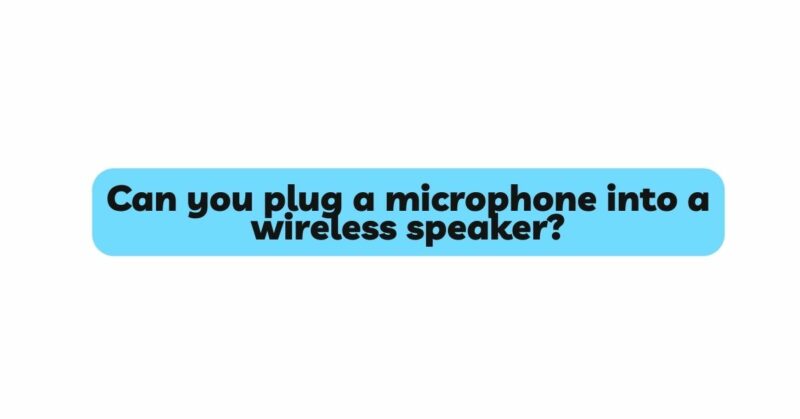The world of audio technology continues to evolve, and the integration of wireless technology has brought about a myriad of possibilities. One intriguing question often arises: can you plug a microphone into a wireless speaker? In this comprehensive article, we will delve into the intricacies of connecting microphones to wireless speakers, exploring the technical aspects, compatibility considerations, and potential applications of this innovative combination.
Understanding Microphones and Wireless Speakers: Microphones are devices designed to capture sound and convert it into an electrical audio signal, while wireless speakers are designed to amplify and reproduce audio wirelessly. Both technologies play essential roles in live performances, presentations, events, and everyday audio setups.
Types of Microphones: Before delving into the connection process, it’s crucial to understand the different types of microphones:
- Dynamic Microphones: Known for their durability and versatility, dynamic microphones are commonly used on stages and in recording studios. They generate an electrical signal through electromagnetic induction when the diaphragm moves in response to sound waves.
- Condenser Microphones: These microphones offer superior sensitivity and are often used for capturing studio-quality audio. They require power (phantom power) to charge the internal electronics that amplify the audio signal.
- Lavalier Microphones: Also known as lapel mics, these are small clip-on microphones frequently used in presentations, interviews, and broadcasting. They are often omnidirectional, capturing sound from all directions.
Wireless Speaker Technologies: Wireless speakers have become increasingly popular due to their convenience and versatility. They utilize technologies like Bluetooth, Wi-Fi, and RF (Radio Frequency) to receive audio signals from various sources, such as smartphones, tablets, and computers.
Connecting Microphones to Wireless Speakers: While the concept of connecting a microphone to a wireless speaker may seem straightforward, it’s important to note that not all wireless speakers are designed to accommodate microphone inputs. However, there are several ways to achieve this connection:
- Bluetooth-Enabled Speakers: Many modern wireless speakers are equipped with Bluetooth capabilities. Some Bluetooth speakers come with a built-in microphone, allowing them to serve as a speakerphone. While you can’t directly plug a microphone into these speakers, you can pair a Bluetooth-enabled microphone or transmitter with the speaker to transmit the microphone’s audio wirelessly.
- Wireless Microphone Systems: These systems consist of a wireless microphone (transmitter) and a receiver. The receiver can be connected to a wireless speaker with compatible inputs, such as an auxiliary (AUX) port. This setup enables you to capture audio with the microphone and transmit it to the speaker for amplification.
- Adapter and Cable Setup: Some wireless speakers come with a 3.5mm auxiliary input, allowing you to connect external devices. In this scenario, you can use an appropriate adapter and cable to connect a microphone with a 3.5mm output to the speaker.
Compatibility and Considerations: Connecting a microphone to a wireless speaker requires attention to compatibility and technical details:
- Microphone Type: Dynamic microphones are generally the easiest to connect, as they do not require additional power sources. Condenser microphones may require phantom power, which is not available in all setups.
- Microphone Output: Ensure the microphone’s output matches the input requirements of the speaker. Adapters or cables may be necessary to bridge any gaps.
- Microphone Impedance: Matching the microphone’s impedance with the speaker’s input impedance helps maintain optimal audio quality.
Applications of Microphone-Speaker Connection: The ability to connect a microphone to a wireless speaker opens up various creative applications:
- Presentations and Speeches: Connecting a lavalier microphone to a wireless speaker enables presenters to move freely while amplifying their voices, enhancing engagement and clarity.
- Small Performances: Musicians can use a dynamic microphone to amplify their vocals or instruments when performing in intimate settings.
- Outdoor Events: Wireless microphones and speakers can be invaluable for outdoor events, where wired setups are impractical.
Tips for Successful Connection: Achieving a successful microphone-speaker connection requires attention to detail:
- Check Compatibility: Confirm that the microphone and speaker are compatible in terms of connections and power requirements.
- Use Quality Cables and Adapters: Invest in good-quality cables and adapters to ensure reliable audio transmission without signal loss or interference.
- Monitor Audio Levels: Adjust microphone and speaker volumes to prevent distortion or feedback, ensuring clear and balanced audio.
Conclusion: The intersection of microphones and wireless speakers presents exciting possibilities for enhancing audio experiences. While the direct “plug and play” approach might not always apply, innovative solutions like Bluetooth-enabled microphones, wireless microphone systems, and proper adapters enable us to connect microphones to wireless speakers with careful consideration of compatibility and technical details. Whether for presentations, performances, or events, the fusion of these technologies continues to shape the way we interact with audio, creating new avenues for creativity and communication.


